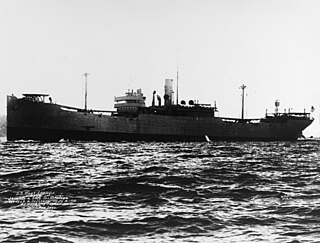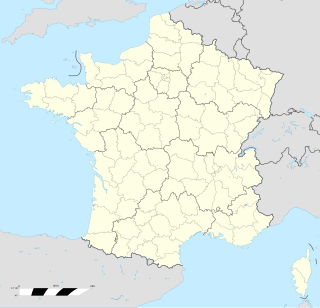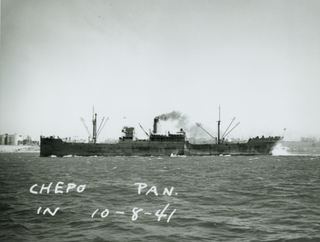
The first USS Amphion was a former German passenger liner SS Köln for Norddeutscher Lloyd from 1899–1917. Köln had been interned in Boston on the outbreak of war in Europe and confiscated in April 1917 when the United States entered the war. The ship was under the control of the United States Shipping Board (USSB) that allocated commercial type ships to military or civilian use during the war. Köln was renamed Amphion and operated by USSB for the Army as United States Army Chartered Transport (U.S.A.C.T.) Amphion as an animal transport taking mules, horses and general cargo to forces in Europe. At the end of the war the USSB allocated the ship to the Navy, which used the ship from April to September 1919 as a troop transport for returning the United States Expeditionary Force from Europe.

The SS Empire Miniver was a British steam merchant ship. She was originally an American merchant, launched in 1918 as SS West Cobalt. During a brief stint in the United States Navy in 1919, she was known as USS West Cobalt (ID-3836).

SS Empire Simba was a British steam-powered cargo ship. She was originally an American ship, launched in 1918 as SS West Cohas. During a stint in the United States Navy from 1918 to 1919, she was called USS West Cohas (ID-3253).

USS West Lianga (ID-2758) was a cargo ship for the United States Navy during World War I. She was later known as SS Helen Whittier and SS Kalani in civilian service under American registry, as SS Empire Cheetah under British registry, and as SS Hobbema under Dutch registry.

USS West Ekonk (ID-3313) was a cargo ship for the United States Navy during World War I. She was later known as SS West Ekonk in civilian service under American registry, and as SS Empire Wildebeeste under British registry.

SS Empire Bunting was a 6,318 GRT cargo ship which was built in 1919. She saw service between the wars under the US flag and was transferred to the UK Ministry of War Transport in the Second World War. She made a number of cross-Atlantic voyages, often sailing in convoys. She ended her career by being sunk as a blockship on the Normandy coast, supporting the allied landings there in 1944.

Empire Barracuda was a 4,972 GRT cargo ship which was built in 1918 for the United States Shipping Board (USSB) as Sacandaga. She was sold to American Diamond Lines Inc in 1932 and renamed Black Heron. In 1941 she passed to the Ministry of War Transport (MoWT) and was renamed Empire Barracuda. She was torpedoed on 15 December 1942 and sunk by U-77.

USS West Haven (ID-2159) was a steel–hulled freighter that saw service with the U.S. Navy during World War I, and which later saw convoy service during the Battle of the Atlantic in World War II.
West Cawthon was a steam cargo ship built in 1919 by Southwestern Shipbuilding Co. of San Pedro for the United States Shipping Board (USSB) as part of the wartime shipbuilding program of the Emergency Fleet Corporation (EFC) to restore the nation's Merchant Marine. Initially, the vessel was placed in the Pacific trade, but was soon acquired by the Green Star Steamship Co. and was put on the Gulf to the Mediterranean route. In 1923 Green Star Steamship Co. went bankrupt and vessel was bought back by USSB. The freighter then spent next two years serving the Mediterranean ports of Italy and Spain before being laid up late in 1924. In 1926 the vessel was bought by the American-South African Line and for the next fourteen years continuously sailed between the East Coast of the United States and South Africa. In 1940 she was sold to the Ministry of War Transport (MoWT) and renamed Empire Bison. The ship was torpedoed and sunk by German submarine U-124 on 1 November 1940 on one of her regular convoy trips.

Empire Buffalo was a 6,404 GRT Design 1105 cargo ship which was built in 1919 as Eglantine by Skinner & Eddy for the United States Shipping Board (USSB). She was sold in 1933 to the Lykes Brothers-Ripley Steamship Corporation. In 1940 she was sold to the Ministry of War Transport (MoWT) and renamed Empire Buffalo. She was torpedoed and sunk by U-125 in 1942.
SS Empire Chamois was a 5,864 GRT cargo ship which was built in 1918 by Ames Shipbuilding and Drydock Co, Seattle. She was ordered by the Compagnie Générale Transatlantique but was requisitioned by the United States Navy and commissioned as USS West Mount with the pennant number ID-3202 in 1918. She was decommissioned in May 1919 and passed to the United States Shipping Board (USSB) as SS Westmount. In 1927 she was sold to the Dimon Steamship Corporation and renamed SS Pacific Redwood. She returned to the USSB in 1932 and passed to the United States Maritime Commission (USMC) in 1937. In 1940, she was passed to the Ministry of Shipping, passing to the Ministry of War Transport in 1941 and being renamed SS Empire Chamois. She was sold to Astral Shipping Co Ltd in 1946 and renamed SS Granview. In 1949 she was sold to the Compagnia Maritime del Este, Panama and renamed SS Chamois, serving until 1958 when she was scrapped. She was the last Ames-built ship afloat.

Polar Chief was an 8,040 GRT tanker which was built in 1897 as the cargo ship Montcalm. In 1914 she was requisitioned by the Admiralty, serving initially as a troopship. In October 1914, she was converted to a dummy battleship and renamed HMS Audacious. In 1915 she became a depot ship, followed by conversion to a tanker in 1916 when she was sold into Royal Fleet Auxiliary service and renamed RFA Crenella. In 1917, she survived a torpedo attack off the coast of Ireland. In 1919, she was sold into merchant service as SS Crenella.

Western Maid was a 5,760 GRT cargo ship that was built in 1918 by the Northwest Steel Company, Portland, Oregon, USA. She was built for the United States Shipping Board (USSB), but was commissioned into the United States Navy on completion as USS Western Maid, with the pennant number ID-3703. In 1919 she was decommissioned and returned to the USSB. In 1937 she was passed to the United States Maritime Commission. In 1940 she was transferred to the British Ministry of Shipping and renamed Empire Cormorant, passing to the Ministry of War Transport (MoWT) in 1941. In 1945 she was scuttled in the North Atlantic with a cargo of obsolete war matériel.

Empire Crossbill was a 5,463 GRT Design 1013 cargo ship that was built in 1919 by Los Angeles Shipbuilding & Drydock Company, San Pedro, California, United States for the United States Shipping Board (USSB). She was transferred to the United States Maritime Commission (USMC) in 1937 and the Ministry of Transport (MoT) in 1941, serving until she was torpedoed and sunk on 11 September 1942 by U-82 in the Atlantic Ocean while a member of Convoy SC 42.
Ruth Kellogg was a 5,037 GRT tanker that was built in 1920 as the Design 1025 Hog Islander Calaumet by American International Shipbuilding, Hog Island, Philadelphia, Pennsylvania, United States for the United States Shipping Board (USSB). Completed as Vaba, she was converted to a tanker in 1921. A sale in 1929 saw her renamed Ruth Kellogg. In 1940, she was transferred to the British Ministry of War Transport (MoWT). Renamed Empire Dolphin in 1941, she served until 1947 when she was scrapped.

Empire Dorado was a 5,595 GRT design 1019 cargo ship that was built in 1920 as Tolosa by Atlantic Corporation, Portsmouth, New Hampshire, United States for the United States Shipping Board (USSB), passing to the United States Maritime Commission (USMC) in 1937. She was sold to the United Kingdom in 1940, passed to the Ministry of War Transport (MoWT) and renamed Empire Dominica. She served until November 1941, when she was in collision with another ship. Although taken in tow, she subsequently sank.

Empire Eland was a 5,613 GRT Design 1019 cargo ship that was built in 1920 as West Kedron by Long Beach Shipbuilding Co, Long Beach, California, United States for the United States Shipping Board (USSB). She was transferred to the United States Maritime Commission (USMC) in 1937. In 1940, she was transferred to the Ministry of War Transport (MoWT). She was torpedoed and sunk by U-94 on the night of 15–16 September 1941.
West Caddoa was a Design 1019 cargo ship built in 1919 by the Western Pipe & Steel Co of San Francisco. She was one of many ships built by the company for the United States Shipping Board.

West Pocasset was a steam cargo ship built in 1919 by Northwest Steel Company of Portland for the United States Shipping Board as part of the wartime shipbuilding program of the Emergency Fleet Corporation (EFC) to restore the nation's Merchant Marine. The freighter was operated sparingly on the United States to Europe routes during the first two years of her career before being laid up. The ship was briefly reactivated in 1929 but was again laid up next year and remained idle for the next ten years. In January 1941 the freighter was sold together with four other vessels to the United States Line and was put under operation by its fully owned Panama-registered subsidiary to carry war matériel and supplies between Canada and United Kingdom and renamed Chepo. In early January 1942 while on one of her regular convoy trips, she was torpedoed and sunk by German submarine U-43 with the loss of seventeen men.

Missourian was an early American motor cargo ship which was built in 1921 in Chester, Pennsylvania, for the American-Hawaiian Steamship Company. She was sold to the British Ministry of War Transport in 1940 and renamed Empire Swan. Transferred to the Belgian government in 1942, she was renamed Belgian Freighter. She was sold to the Compagnie Maritime Belge in 1946 and renamed Capitaine Potié.















